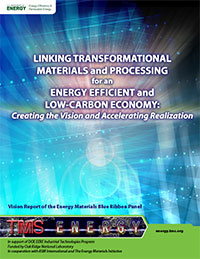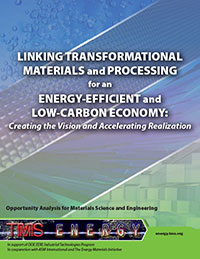TMS was commissioned by the U.S. Department of Energy’s (DOE) Advanced Manufacturing Office (formerly the Industrial Technologies Program) in February 2010 to lead a three-part study into areas where new materials and processing breakthroughs can lead to transformational advances in energy efficiency, energy security, and carbon emission reduction.
The outcomes of this study were summarized in three reports, representing the three phases of the project. All three reports are available for free download below. See “Related Resources” to find nontechnical project summaries.
PHASE ONE REPORT:
 Linking Transformational Materials and Processing for an Energy-Efficient and Low-Carbon Economy: Creating the Vision and Accelerating Realization —
Linking Transformational Materials and Processing for an Energy-Efficient and Low-Carbon Economy: Creating the Vision and Accelerating Realization —
Vision Report of the Energy Materials Blue Ribbon Panel
Publication Date: June 2010
This document distills the Energy Materials Blue Ribbon Panel's assessment of materials and processing elements with the highest impact potential across energy source and use into four cross-cutting themes.
PHASE TWO REPORT:
 Linking Transformational Materials and Processing for an Energy-Efficient and Low-Carbon Economy: Creating the Vision and Accelerating Realization —
Linking Transformational Materials and Processing for an Energy-Efficient and Low-Carbon Economy: Creating the Vision and Accelerating Realization —
Opportunity Analysis for Materials Science and Engineering
Publication Date: January 2011
This report identifies broad technology areas for future study.
PHASE THREE REPORT:
 Linking Transformational Materials and Processing for an Energy-Efficient and Low-Carbon Economy: Creating the Vision and Accelerating Realization —
Linking Transformational Materials and Processing for an Energy-Efficient and Low-Carbon Economy: Creating the Vision and Accelerating Realization —
Innovation Impact Report
Publication Date: February 2012
The capstone report of the TMS/U.S. Department of Energy project on energy materials, this publication identifies more than 50 materials innovation opportunities that can deliver significant energy savings, environmental gains, and economic advantages in the next two to ten years.
Related Resources
- Materials: Foundation for the Clean Energy Age: A non-technical summary of TMS/U.S. Department of Energy project findings related to energy materials, this booklet offers a succinct summary of a cadre of breakthrough materials and manufacturing technologies that can yield significant results in the near-term, along with suggested strategies to ensure that these potentially game-changing research innovations are transitioned effectively to realistic commercial implementation.
- Innovation Impact Report Webinar: Outlines the key findings and recommendations of the Innovation Impact Report coordinated by TMS on behalf of the Department of Energy. Includes all presentations and Q&A portion of the March 6, 2012 webinar.
- Innovation Impact Report Summary: A one-page overview of the topic areas and key findings of the Innovation Impact Report.
- Project Milestones: A one-page summary of project milestones.
- "Laying the Foundation for the Clean Energy Age," Lynne Robinson, February 2012 JOM. A roundtable interview with members of the Energy Materials Blue Ribbon Panel on the key takeaways of the Innovation Impact Report.
- "An Update on the TMS Energy Materials Study," Lynne Robinson, July 2011 JOM. In this roundtable interview, the Innovation Impact Team chairs leading the third phase of the TMS "Linking Transformational Materials and Processing" study offer their perspectives on the project's progress and potential impact.
- "Transformational Energy Materials Project Launches Next Phase," Lynne Robinson, September 2010 JOM. This article introduces the chairs of the Technical Working Groups who led Phase II of the “Transformational Energy Materials Project,” while also providing an overview of their goals and processes.
- Advanced Materials for Our Energy Future: Developed by TMS and four other materials societies, this publication underscores the importance of materials science and engineering (MSE) in meeting energy challenges.
Project Partners
-
The Minerals, Metals & Materials Society (TMS)
- In support of the U.S. Department of Energy’s Office of Energy Efficiency & Renewable Energy’s Advanced Manufacturing Office (formerly the Industrial Technologies Program)
- In cooperation with ASM International and The Energy Materials Initiative
- Funded through Oak Ridge National Laboratory